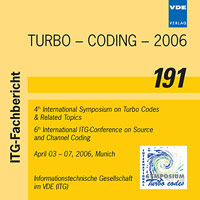An intuitive way to calculate a lower bound on a convergence threshold for LDPC codes
Konferenz: TURBO - CODING - 2006 - 4th International Symposium on Turbo Codes & Related Topics; 6th International ITG-Conference on Source and Channel Coding
03.04.2006 - 07.04.2006 in Munich, Germany
Tagungsband: TURBO - CODING - 2006
Seiten: 4Sprache: EnglischTyp: PDF
Persönliche VDE-Mitglieder erhalten auf diesen Artikel 10% Rabatt
Autoren:
Hehn, Thorsten; Dönmez, Andac; Huber, Johannes B. (Chair for Information Transmission, Cauerstr. 7, 91058 Erlangen, Germany)
Inhalt:
Belief-propagation decoding for low-density parity-check (LDPC) codes only performs well if the decoder does not get stuck during information exchange between variable and check nodes, i.e. performs above a certain threshold. As the binary erasure channel and the binary symmetric channel are both the least and most informative channels from information combining point of view (depending on the type of nodes being considered (variable- or check-)), one can calculate upper and lower bounds on the required mutual information that has to be sent over the channel for successful iterative decoding. In this paper we present an additional easily understandable methodology for calculation of the lower bound for the required mutual information. Our method is intuitive as its approach is based on EXIT charts.


